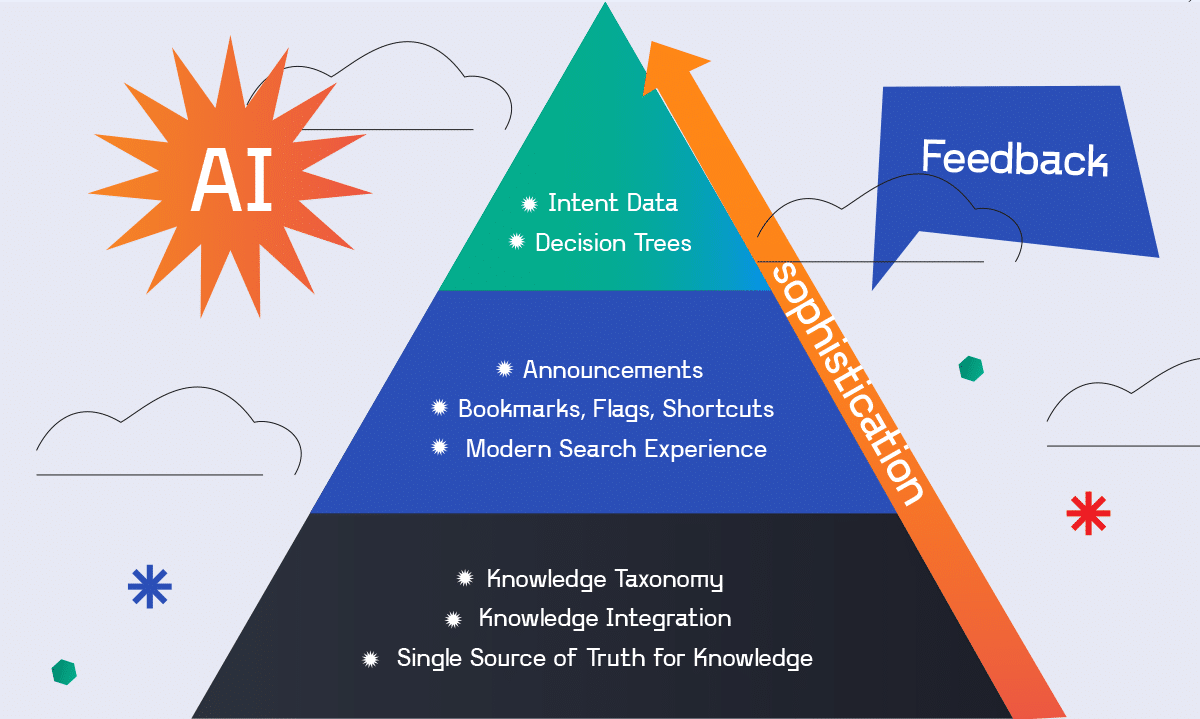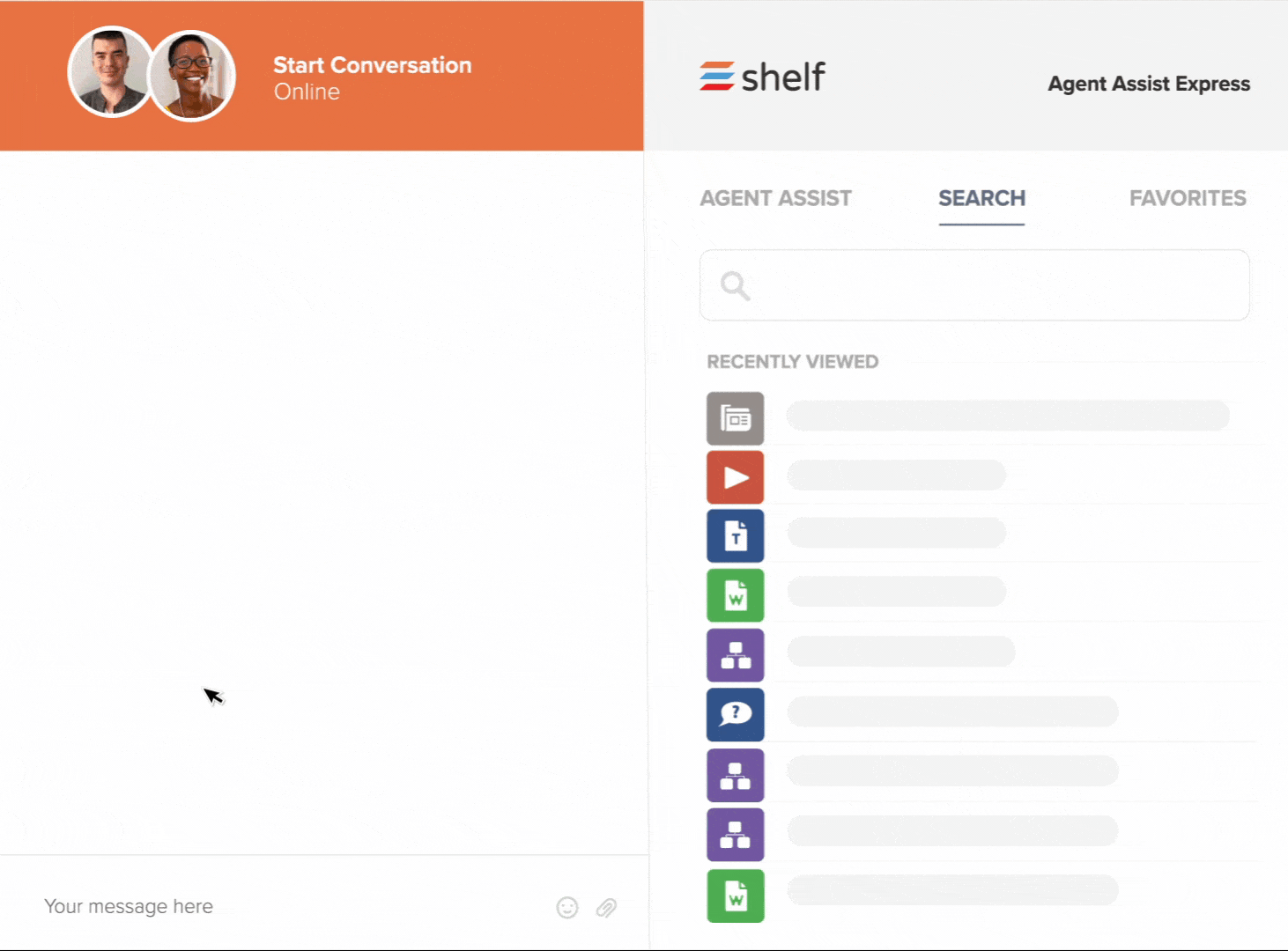How can you improve agent productivity? You have access to so much technology as a customer support leader these days, yet studies show frustrated customers complain most about things like ineffective and slow customer support agents. If customer support technology is so good—the platforms, IVR systems, the chatbots—why do companies still struggle with inefficient support agents?
Improve Agent Productivity by Addressing the Real Cause of Agent Inefficiency
Inefficiency kicks in once a call with a customer begins, once a chat begins, once an agent must begin their search for answers. The time customer service agents waste searching for the right knowledge is the real cause of agent inefficiency. In search of answers, many agents still weed through dozens of browser tabs or send messages to their coworkers each day. These tasks are the real time-wasters that impact handle times and other metrics you care about, and do not improve agent productivity.
The Agent Efficiency Pyramid
The good news: you can improve agent efficiency on your customer support team starting with a few knowledge management fundamentals; to help you gauge where to begin, we’ve created what we call the Agent Efficiency Pyramid for customer service.
As the diagram below illustrates, all initiatives start with basic knowledge management principles—These principles at the base of the pyramid are foundational to maximizing agent efficiency; other, more sophisticated initiatives further up the pyramid build on top of a modern knowledge infrastructure.

Two important concepts—artificial intelligence and continuous feedback—we’ve placed on the outside of the pyramid; These two concepts will help you advance from one initiative to the next and act as fuel needed to reach the top and maximize efficiency.
You should always have a feedback mechanism to ensure your customers and support agents can provide feedback, whenever you update a piece of content, whenever you adjust a taxonomy, whenever you add a branch to a decision tree. AI plays a critical role too: it powers answer recommendations for your agents and recommends content changes for your knowledge team (even if agents don’t provide feedback).
You can start making progress with your current knowledge solution, but to reach the top of the pyramid, you’ll need a modern knowledge management solution. If you’re in-market for a new solution, get your copy of our KM buyer’s guide for smarter knowledge management to share with your knowledge manager.
In the rest of the post, we’ll walk through each level on the pyramid, starting at the bottom with basic principles you should prioritize first.
1. Improve agent productivity by having a source of truth for knowledge. Stop the endless searching!
Simply put: Don’t force your agents to endlessly search for a resource in a time of need–have a single source of truth for knowledge. This does not help improve agent productivity.
All other efficiency improvements you make should build on the same foundational principle: knowledge consolidated to one central location that can be surfaced in multiple channels. How agents access information manually (or receive recommendations automatically) impacts efficiency as you’ll read, so agents should know what your official knowledge source is and use it.
2. Integrate knowledge into the agent desktop experience
Wherever you can, integrate knowledge into the desktop environment your agent spends time interacting with customers—whether that be Salesforce, Genesys, Five9, NICE, or any other vendor your support team uses. Agents shouldn’t need to log into 3 applications to find what they need, spend more time if the app requires 2-factor authentication, and also manage a browser full of open tabs.
You maximize efficiency for agents when your knowledge source is embedded and searchable within the platform used to handle the support request —no tab switching needed.
Browser tabs are like mushrooms. You try to kill them, and they just pop right back up again.”
3. Eliminate unnecessary clutter: only allow access to relevant knowledge
You shouldn’t overload an agent’s desktop environment, and you also shouldn’t force agents to sift through information that doesn’t apply to them. If your support team has access to 10,000 articles in your knowledge base, some agents may only need access to 500 of them depending on their support tier.
A modern knowledge management solution will allow you to set permissions for each user role or user group, like agents and knowledge managers. Setting up user permissions or content-level permissions will save agents time. More content is not necessarily better content, especially if agents must navigate a complicated folder structure to find what they need; some documents that aren’t relevant for agents will only slow them down.
4. Create an easy-to-navigate structure for knowledge
Like permissioning, you can improve agent efficiency by optimizing your knowledge taxonomy, or structure your organization uses to organize knowledge. Your agents probably spend time in folders and subfolders looking for documents; how your knowledge admin creates hierarchies will either add or save time for agents.
Knowledge managers should communicate with agents before organizing information into a taxonomy; everyone’s brains are wired differently, one folder structure that makes perfect sense to one person, could be confusing to another. For this reason, create a taxonomy that’s intuitive for all agents.
Sometimes it’s easier for agents to look through folders if they don’t know what keywords to use in a query; the search function helps agents much of the time, but not in every case. Agents still can save time browsing through folders if the only other alternative is finding a coworker who may or may not know the answer. Be sure to also periodically audit and update your organization’s knowledge taxonomy—this simple task will help reduce confusion for agents and improve productivity over time.
5. Deliver a modern search experience
We live in the age of autocomplete—including your agents; an age where search engines return information without even needing to press the “search” button. Since agents prefer a Google-like search experience when they know what to search for, you can save time for agents if your knowledge management platform mimics this experience.

You can save agents even more time if embed your knowledge solution’s search function directly in the support environment—don’t force agents to switch tabs if they don’t have to!
6. Encourage agents to use bookmarks, flags, and shortcuts
If your agents struggle with efficiency in general—not just during customer interactions—encourage them to use bookmarks, shortcuts, and any other strategies you can think of that will make it easier for them to organize their work life.
Get creative, record a tutorial on how agents can flag or favorite content. Some knowledge management platforms give you the ability to add content to a list of favorites, for those frequently used articles.
7. Notify agents when content changes to avoid confusion
Experienced agents can often recite a policy verbatim without the need for a knowledge article…until that policy changes. Agents need to be notified when important content changes so they can break the connection to knowledge that has been hard wired in their brains.
Your knowledge administrator should ensure agents read and acknowledge important changes to content types—if not, agents may waste time reciting old information that confuses a customer or causes a customer to call back later.
Sending out a simple announcement helps prevent agents from being caught off guard on a call; no agent wants to frantically search for an updated policy, or ask a coworker (who also may not know about the change).
8. Do more with voice data provided by your customers
As you move up the agent efficiency pyramid, you get to projects that harness the power of voice.
Studies show 62 percent of customers still prefer human interaction—and customers provide a lot of voice data your agents can use to streamline day-to-day tasks. Many IVR systems use intent data to map calls, why not use the same intent data to provide context for agents once the call connects?
Your customers should never repeat information they just gave your IVR system if you can help it; thanks to advances in natural language processing they no longer have to.
You can still do more to boost agent efficiency with voice, even if you already provide a voice transcription within your agent’s contact center environment. Knowledge platforms like Shelf can now take this IVR intent data, generate recommendations from your knowledge source using AI, and present these recommendations to agents in real-time.
9. Make it easier for agents to leave feedback on content
Your entire support team should always provide feedback on content to keep it fresh; it should be easy to leave a comment or two…it’s often not. Many companies force agents to use tools outside of their support environment (like Jira) to report problems with content. The problem? Agents must open yet another tab, log in, and hope they remember the process. If your content feedback process is too involved, don’t expect agents to follow it.
Out of date content leads to incorrect answers—and even more wasted time. You should make it easy for agents to leave a comment or leave a star rating when they use knowledge, so your content admins will know what needs updating.
10. Tap into decision trees
Agents spend a ton of time troubleshooting complex problems, especially if they must use scripts or find. Decision trees are a huge time saver because they give agents the next question to ask based on input from customers. You should always set up decision trees if knowledge management system offers them.
To learn more about decision trees and how they can help your agents, check out our post Decision Trees 101.
Save time for agents and customers: make knowledge your top priority
Knowledge should be the #1 priority to eliminate wasted time, no matter what tactics on the Agent Efficiency Pyramid your team has implemented in the past. Agents need a knowledge source that’s reliable and up to date to be efficient—no matter what cool new technology you already have in place.
As a first step, review these common knowledge management mistakes (like managing knowledge in silos), to improve the quality of your existing knowledge. Some simple structural changes will pay off immediately for your agents as you can work your way up the ladder to more sophisticated tactics.






